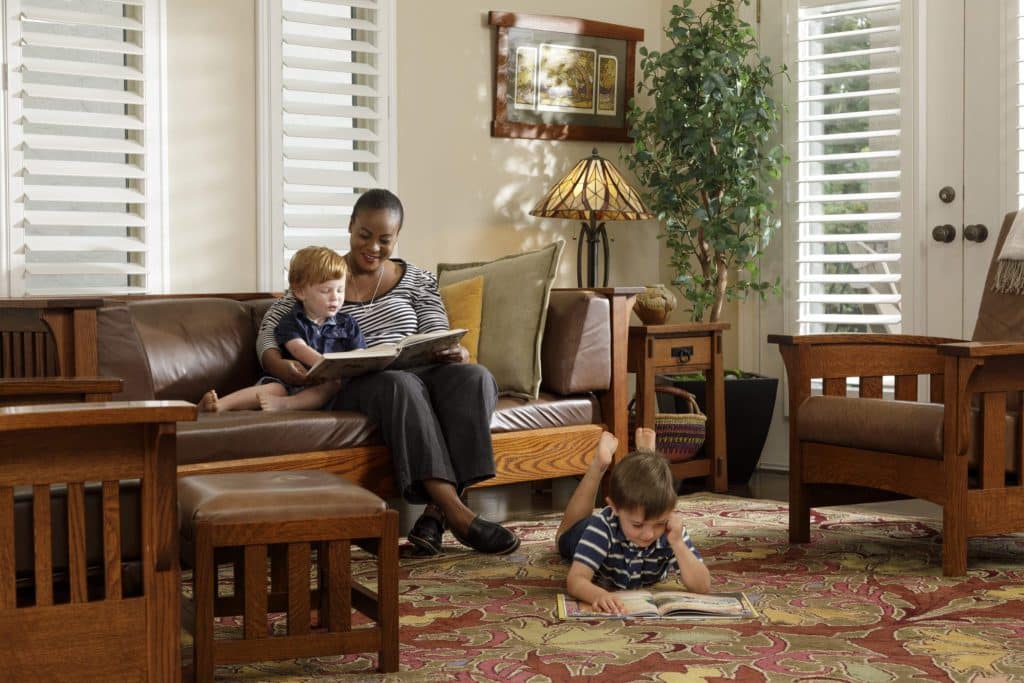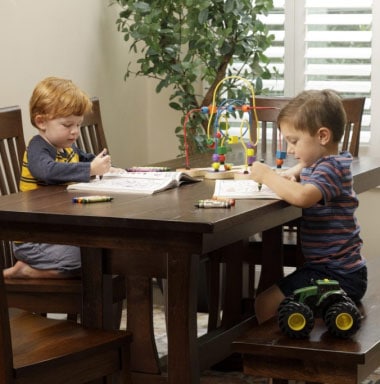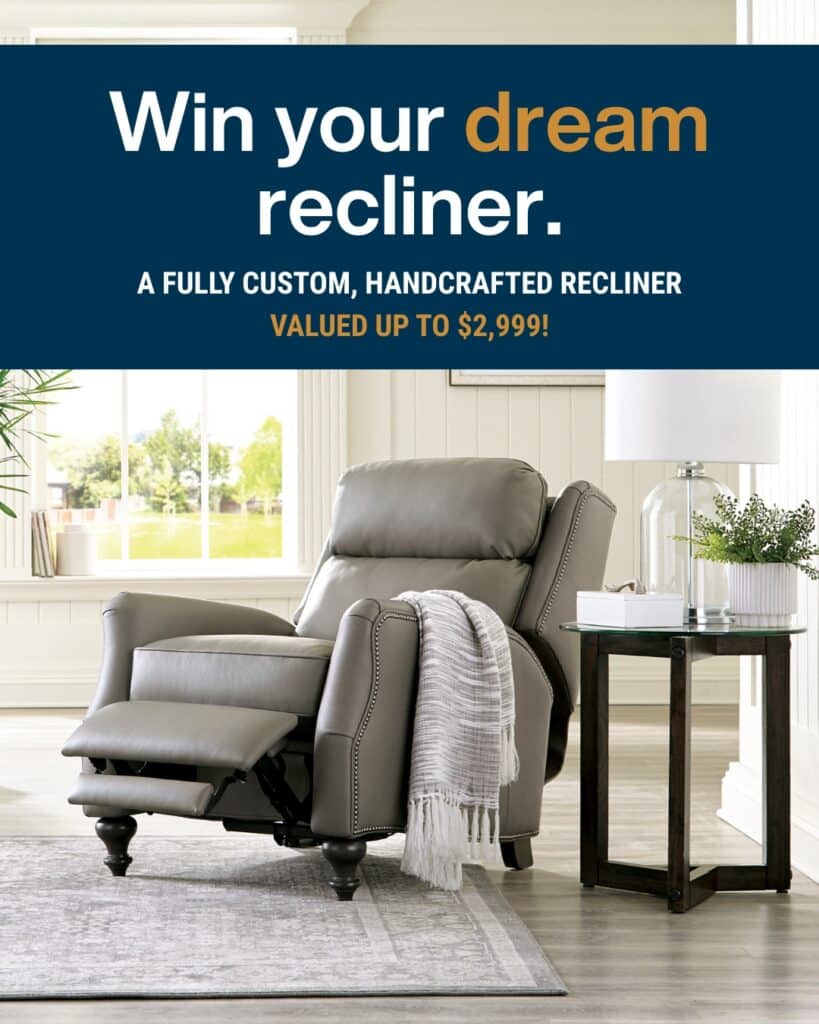When it comes to designing a room in your home, there are unlimited options, styles, and ways to do it.
The potential is exciting, but it can be overwhelming!
It is exciting to personalize a room exactly the way you want it. But there are so many options it can be overwhelming sometimes!
At The Amish Craftsman, we know you want a personalized home with quality furniture, great decor, and a personal touch.
That is why we put together this guide – 8 keys to designing your perfect living room!
And if you are feeling overwhelmed – don’t panic! We will walk through it step by step together.
If you are ready to begin designing your perfect space, keep reading!
Use A Design Board To Create Your Living Room Layout
One of the things that makes a redesign both overwhelming and exciting is the wide range of possibilities. A quick search on Google or Pinterest, or a casual scroll through Instagram quickly reveals thousands of options with unique designs, layouts, furniture, colors, decor, etc.
That can quickly result in option overload. How can you break through all this clutter and come up with a design to fit your style, tastes, and needs?
One simple way to narrow things down is to create a design board.
At the most basic level, a design board is simply a board where you brainstorm the room’s layout and design.
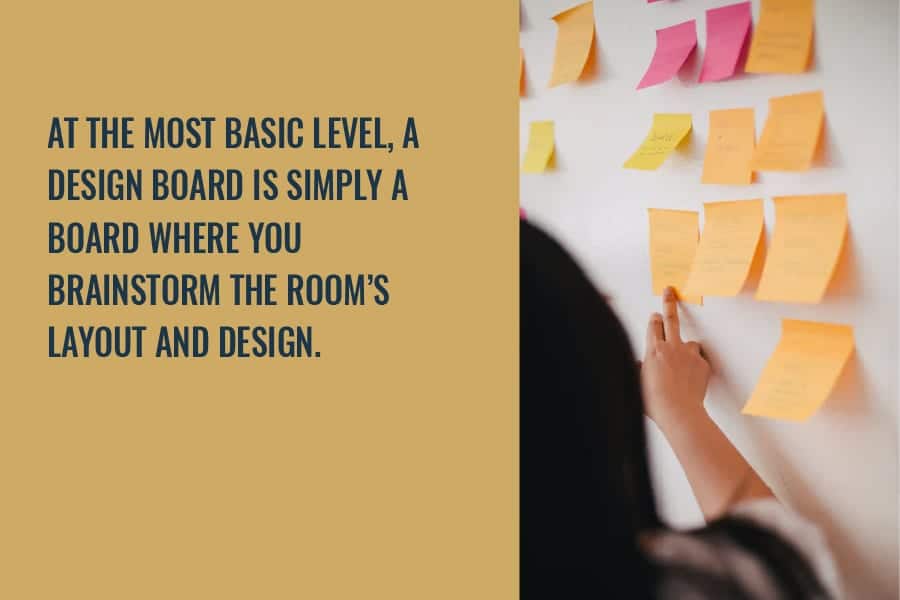
Remember cutting out clothes, toys, or furniture from catalogs when you were a child, and then playing paper dolls or house with the cutouts?
A design board is a similar idea – using photos and images to make mock designs.
If you want to play around electronically, start by getting the rough size of your room in a program like Google Slides or Microsoft Publisher.
Then download images of furniture and decor, or take screenshots, and upload them to the program. Resize the photos to their approximate size, and move them around your “room” electronically to see how the colors and styles fit.
If you prefer doing it on a phone app, there are several apps available that “remove” your room’s current furniture and allow you to add other furniture pieces.
Most of these programs allow you to change your room’s wall colors to help see how different paints and color palettes affect the design and mood. (Paint and stain colors can have a large impact on the mood of your room. If you want to know more, here is our guide on choosing stain colors.)
One thing to consider when using an electronic design board: If you have a blue-light filter installed on your screen or wear blue-light reducing glasses, the colors may not appear as their true coloring. Make sure you remove all blue-light filtering when playing with color schemes.

If you don’t like designing with electronics, simply print the pictures out, or order some furniture magazines and cut out the images you want. Use a tack board or piece of cardboard for the floor and pin the images to it.
No matter the method you choose for your design board, play around with as many design options and layouts as you want. After all, it’s completely free, and it helps you visualize your dream living room without spending money until you are ready.
Establish A Focal Point (and Why It Matters)
As you think about your living room design and the elements you want, you want to establish the room’s focal point.
Just as it sounds, a room’s focal point is the main attraction or center of attention.
Why is this important?
Focal points help anchor the room and give a sense of foundation. Without a good focal point, a room’s layout and decor quickly feel scattered or random.
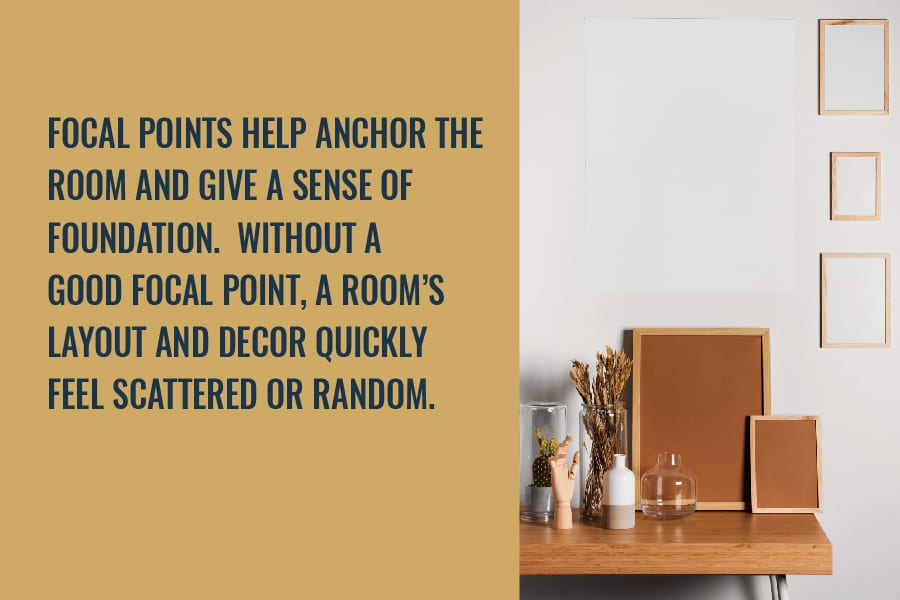
Depending on the room’s structure, it may have a natural focal point already built-in. Some examples of natural focal points include the following:
- A fireplace, especially if a TV is mounted above the mantel
- French doors or windows
- A large built-in bookshelf
- Any permanent feature that draws immediate attention
If your living room doesn’t have a natural focal point, then create a focal point. Common examples of designed focal points include the following:
- A large piece of art
- An oversized clock
- A large hutch or armoire
- A well-organized or large wall photo gallery
- Any decorations designed or placed to catch someone’s attention
Having a singular focal point gives you direction in building your room’s foundation and starting point. The focal point dictates where your main furniture faces, where walkways should be, and where you should place your rugs.

If possible, you should try to have only one focal point in your room. However, if your room naturally has more than one focal point, or if you want to use a piece of furniture (such as an heirloom Grandfather’s Clock), then move on to point three…
How Do You Design Around Multiple Focal Points?
If your living room naturally has more than one focal point, or it has furniture or decorations that create a second focal point, how do you design around the second focal point?
First, choose the primary focal point. Your main furniture should center around the focal point.
Second, think about traffic paths and accessibility to the other focal point(s). You don’t want to block them out or hide them. Instead, allow them to be accessible and open to the room if possible.
Third, if your room is large enough, you may be able to design separate seating areas, with each seating area centered around a different focal point. This breaks up the room and focal points, but it does require plenty of space.
If your room feels too spacious and wide, chunking up the space this way can help it feel cozier as well.
Fourth, if possible, use floor rugs to help break up the room into zones around the focal points. For more information on using rugs, see our section on rugs and floor coverings.
If you have multiple focal points, your goal is not to hide them. Instead, think about how to incorporate your furniture, rugs, and walkways to draw attention to the focal points in a natural way.
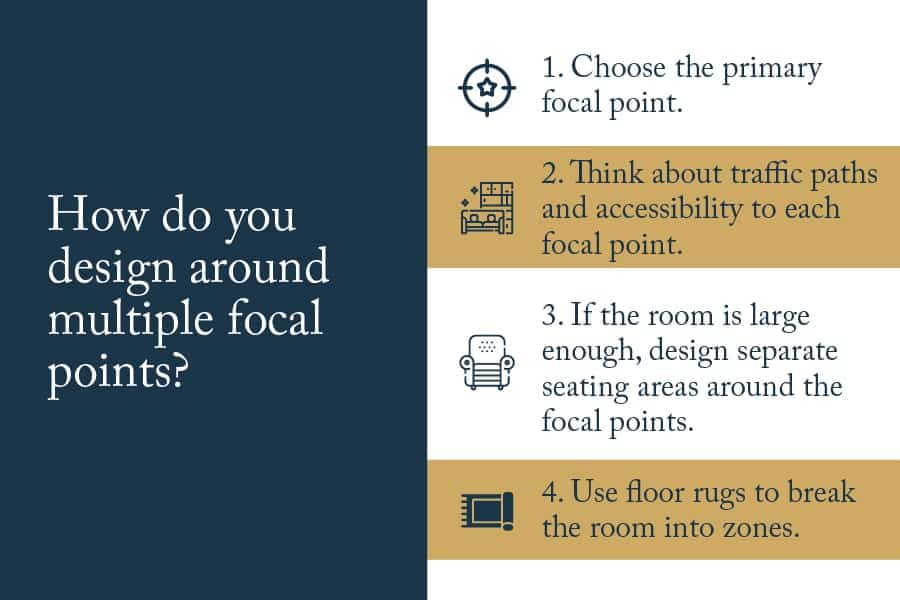
Choosing A Color Palette For Your Living Room
Picking a color for your room’s design may seem confusing at first. There are many different schools of thought on how bright, bold, or transparent a room’s color palette should be.
In recent years, the growing trend is to have your room’s colors complement your room’s focal points and decor instead of playing mainstage.
In her book Habitat: The Field Guide To Decorating, Lauren Liess calls this having a “wingman color,” and she discusses the benefits of choosing the right wingman color for your room.
But first, what is a wingman color, and how does it fit into your design?
A wingman color is a color that complements your room’s focal point, furniture, and decor. Instead of being a bold color that attracts attention, a wingman color is usually a softer color blending into the rest of the room.
In other words, your living room’s colors should draw attention to the focal points of the room instead of causing a distraction.
The exact shades you use in your color palette will vary on your decor and focal point, as well as your personal taste. If you aren’t sure about a color, play around with it on your design board and figure out if you like it with the room’s style and layout.
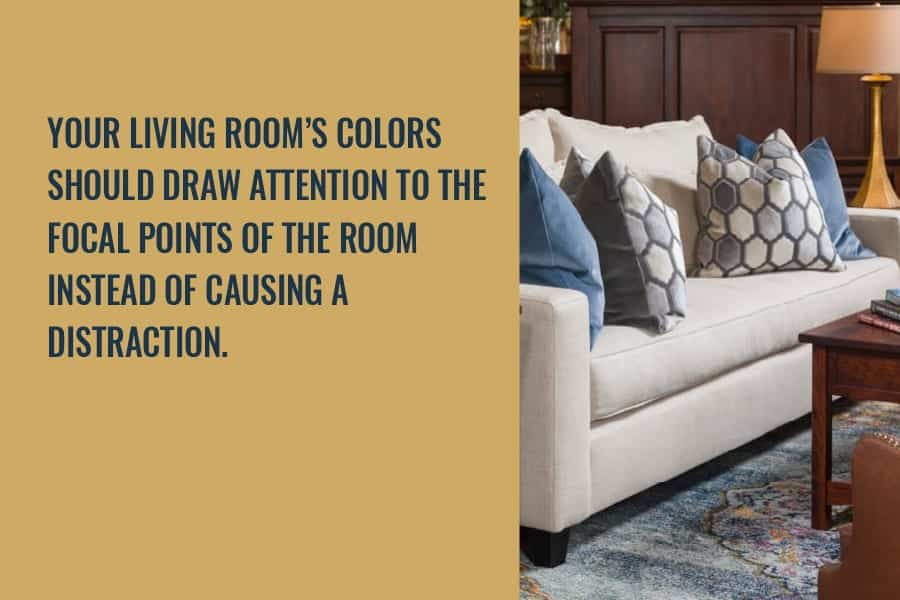
Choosing Your Living Room Furniture
Along with your focal point and colors, your furniture affects your living room’s design.
If you use your design board and have saved images from Pinterest or Instagram, then you may already know the style and design you want for your furniture.
However, don’t forget one key element in choosing your furniture.
Don’t choose furniture simply based on style – make sure you pick comfortable, high-quality furniture! The best living rooms are the ones with super comfy chairs and couches that you can cuddle down on and feel at home.

Many people settle for cheaper furniture to save money, but this results in long-term headaches and uncomfortable seating.
Instead, you should focus on choosing furniture that is stylish, comfortable, and high-quality. Not only does this add beauty to the room, but it also makes hosting and relaxing enjoyable!
For more information on picking high-quality furniture, read our blog post on 13 tips on choosing high-quality furniture. You can also work with our team at The Amish Craftsman to design your perfect living room based on your personal style.
If you love the Mission and Arts and Crafts style, then you’ll love our hardwood living room collection. If your design style leans more traditional, check out our fully upholstered living room furniture.
Incorporating a TV Or Entertainment Center
Planning a living room’s design around a TV or entertainment center is sometimes difficult. Because furniture needs to be centered around the TV for natural viewing, the TV often ends up being the room’s focal point by default.
While this isn’t always a problem, many people want the focal point to be something other than the TV screen.
So, what are some tips and tricks in keeping an entertainment center from dominating the room?
First, it is ideal to keep the TV out of your main living room if possible. If you have a den or spare room, it is easier to turn this room into your TV room and keep your living room as your hosting or relaxation room.
Having a dedicated TV room allows you to optimize the furniture arrangement, entertainment center, and sound for your TV.
Second, if your TV needs to be in the living room, consider how to combine it with another focal point. For example, if your main focal point is a fireplace, you could hang the TV directly above the mantel.
Choosing a wall unit with shelving can create a beautiful focal point while providing space to showcase family pictures, books, and other home decor.
When making the screen part of a focal point, make sure it looks natural! If it looks awkward or unusual, it becomes a distraction.
Third, consider hiding your TV in the decor. Using a hinging mirror, piece of artwork with a piano hinge, or a cabinet with doors hides the screen when it is not in use. Or disguise your screen by putting an attractive, artistic screensaver on for most of the time, to make so it feels like a piece of artwork instead of a screen.
And finally, if your TV is displayed as part of a room’s focal point, consider the location of the TV screen and plan your seating around it.
If the TV is next to a window, make sure you account for any possible glare from outdoor lighting by buying a window covering. You should also consider the placement of your entertainment system’s speakers and sound equipment.
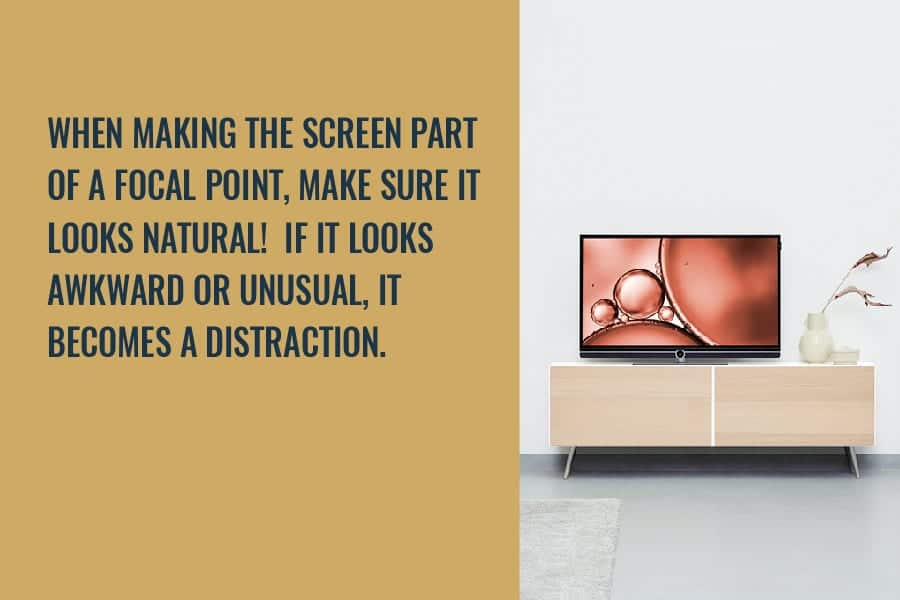
Finding a Place for Everything In your design
Once you have your colors, furniture, and decor picked out, you have to decide on the right layout for everything.
If this process seems overwhelming – don’t worry! Here are some tips for finding a place for everything.
Know the key elements
The four key elements of any room are the focal point(s), your lighting, the seating, and the floor covering. If you know where these key elements fit, the other items start falling into place naturally.
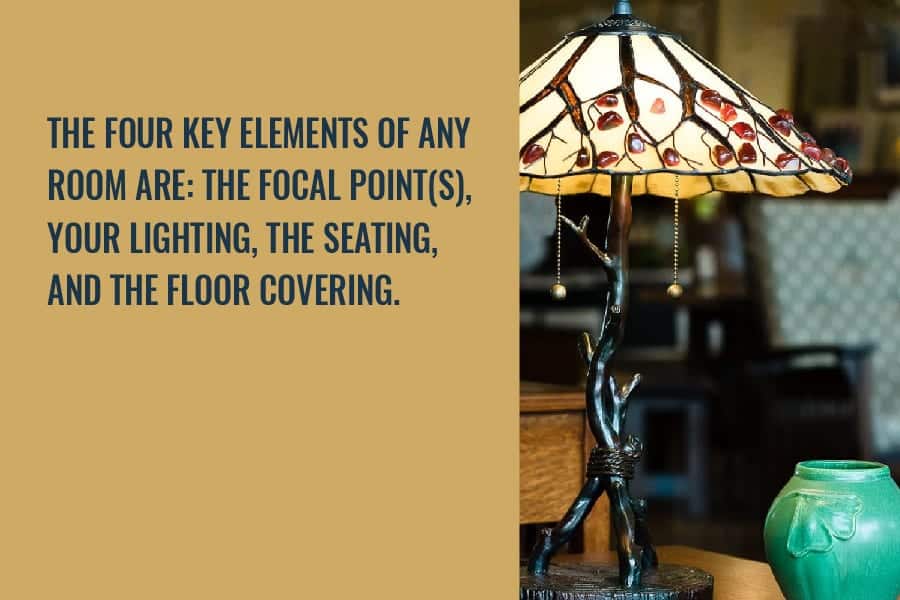
1 – Focal point(s)
As we discussed earlier, it is essential to establish the focal point(s) in your room and use it as the foundation of the living room’s design. Some focal points are stationary (such as a fireplace), and other focal points need to be placed in the room (such as a large bookshelf).
2 – Lighting
You need to keep two things in mind with lighting – ambiance, and practicality.
Your light fixtures need to illuminate the room properly while giving the ambiance you want. Think about the room’s purpose and how your lighting fits into this purpose. You may also need to play around with different wattage light bulbs and warmth.
3 – Seating
Most seating arrangements end up taking a U or L shape centered around a focal point. As you arrange your furniture, make sure there is adequate space for traffic flow and personal space when sitting.
When choosing furniture pieces, it is best to have a mix between simple pieces and larger pieces. You can achieve this by using a variety of sofas, loveseats, and chairs.
If you have an open floor plan or other large open areas, use a rug to define the seating area’s boundaries. Having furniture in an open floor plan without a border makes the furniture feel like it is floating.
4 – Rugs and floor coverings
Rugs are often the single largest element in a room, and they play a significant part in setting the tone of the room, though you don’t always notice.
When sizing a rug for your living room, it is helpful to think of a placemat on a table. Ideally, the rug should hold the furniture and define the room.
Size the rug so the edges outline the furniture grouping, and all the furniture is on the rug, including the back feet. It’s best if there is a little extra “breathing space around the edge of the carpet too, so your furniture doesn’t look crowded onto it. Even if this means the rug takes most of the room, that is OK.
In some cases, the back feet of the furniture might be off the rug if the rug is too small. This is OK if your rug space is limited, but it is still essential to keep the furniture’s front feet on the rug.
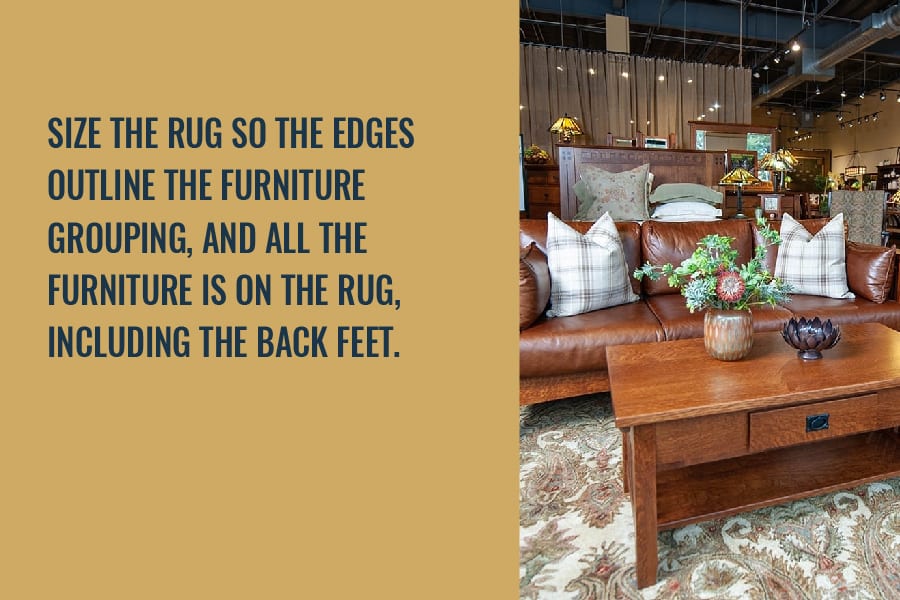
Creating A Child & Pet Friendly Living Room
(14 Tips)
Many people wonder how they should design a living room when children or pets have access to the room. While it is sometimes possible to make your living room inaccessible to pets, most families want the living room to be a place where everyone can be together.
So, how do you make a child and pet-friendly space?
Here are fourteen tips to help you keep your design safe and family-friendly! Click here or scroll to the bottom of this article to get these tips as an infographic.
- Include a rocking chair. This provides a nice relaxing spot for a child or adult, especially when by a window or fireplace.
- Look for fabrics that clean easily and hide stains better. Quality fabrics include krypton or sunbrella, and multi-colored fabrics and patterns hide stains better. Using furniture care products, such as Guardsman, also help protect against stains and accidents.
- Consider adding slipcovers to pillows or cushions to make cleaning easier.
- Leather is a child and pet-friendly material, even though it is more expensive than standard upholstery. Not only does it clean easier, but it also lasts up to five times longer than fabric.
- Avoid sharp corners – choose furniture and decorations with rounded and soft edges.
- Provide plenty of child-friendly seating options with throw pillows, kid-sized chairs, and bean bags. These help children feel welcome and comfortable.
- If you have the room to do a window seat, do it! Children and pets love window seats to look outside and hang out.
- Get strategic with storage for toys and games. Find furniture and baskets which add to your style while providing storage options.
- Make space to play! Whether you have an open area or easily-moved furniture, you need to make sure there is plenty of open area to play and interact.
- Consider furniture pieces with pet beds built into the design. Smaller pieces of furniture, such as end tables, coffee tables, and even sofa tables can be designed with an attached pet bed.
- Design the space for children to play freely while still being in easy access and sight. Children love private nooks and crannies, but design these areas to always be accessible and within easy reach.
- Use books as art. A bookshelf with colorful books makes a beautiful addition, and it encourages reading and learning in children.
- Be careful in displaying heirlooms and other precious decorations. With young children and pets, there is never a guarantee something won’t get knocked down. Keep valuables securely fastened, well out of reach, and in a safe place.
- Choose a paint finish that is easily cleaned and wiped down. For example, eggshell satin and gloss finishes are easily cleaned if an accident happens.
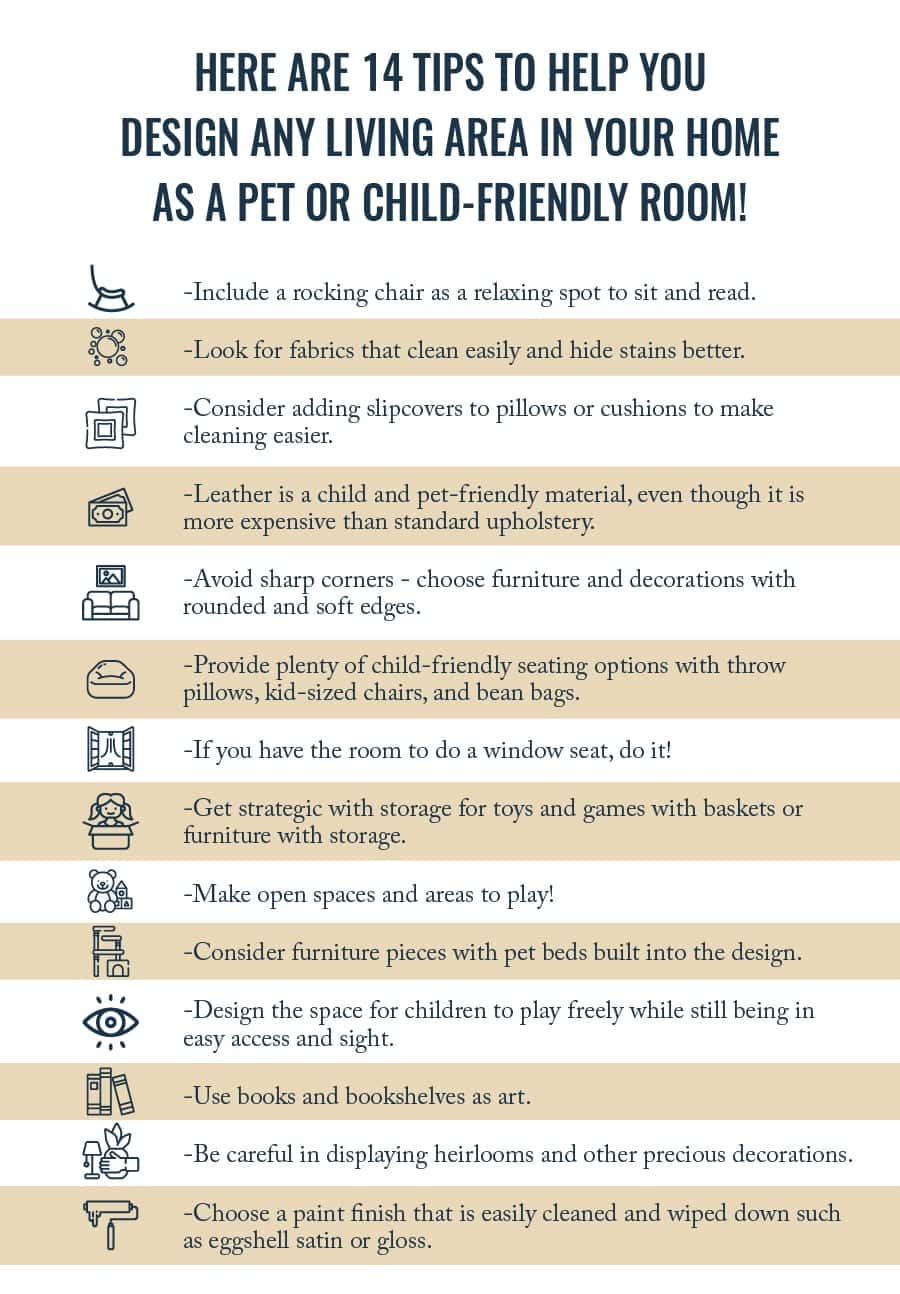
Conclusion
Although it takes some work, designing a living room layout from scratch can be one of the most rewarding things you do in your home and provide a truly personal space in your home!
If you need further ideas or suggestions, please reach out to the team at The Amish Craftsman. We specialize in making truly custom-designed Amish furniture designed to last for generations.
We have more than furniture, too! We also carry:
- Arts and Crafts Rugs
- Craftsman Rugs
- Lighting
- Home Decor
- And furniture for every room in your home!
Our designers are always ready to help you create your dream dining room, living room, bedroom, office, and much more. Contact us today to start making your furniture dreams come true!


